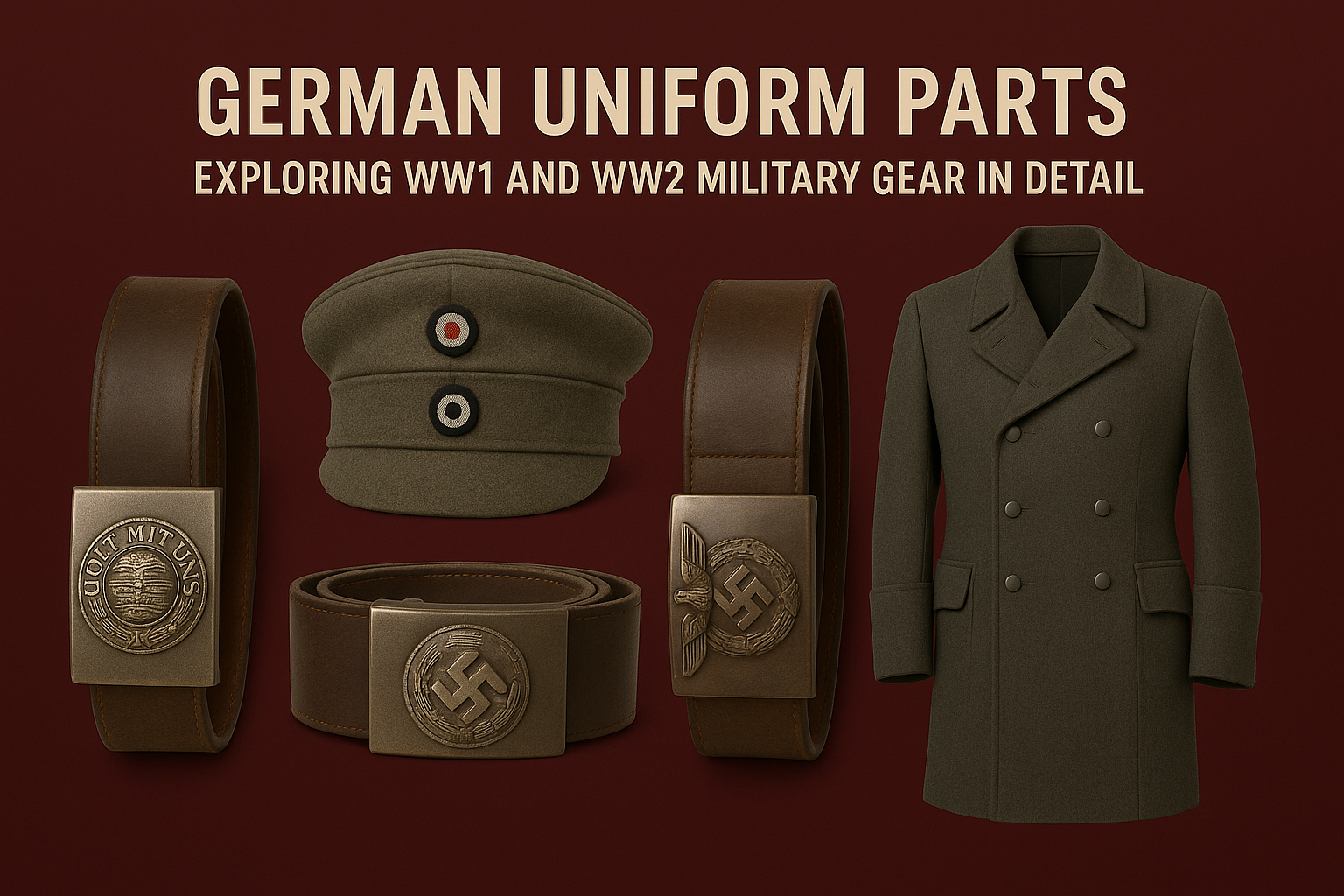
German Uniform Parts: Exploring WW1 and WW2 Military Gear in Detail
Published on May 18, 2025
Introduction: The Legacy of German Military Uniforms
German military uniforms have long captured the attention of historians, collectors, and reenactors. During both World Wars, Germany produced some of the most iconic and meticulously crafted military gear in the world. Uniform parts such as belts, buckles, coats, and caps were not only utilitarian but also symbolic.
Whether you're collecting for display, reenacting historical battles, or simply preserving a piece of history, understanding the differences and significance of German uniform parts from both World War I and World War II is essential.
WW1 German Uniform Parts
WW1 German Belts
The German infantry of World War I relied on durable leather belts as a central part of their uniform. These belts were thick, often made from cowhide, and featured a rectangular buckle engraved with the imperial insignia—usually the phrase “Gott Mit Uns,” which means “God With Us.”
These belts were not merely for style; they served practical functions such as holding ammunition pouches, bayonets, and other field gear. Most were brown or black and aged beautifully over time, which makes them particularly desirable among collectors today.
WW1 German Belt Buckles
The belt buckles used in WW1 came in various designs based on the German state. Prussian buckles, the most common, featured the iconic imperial crown. Bavarian and Saxon versions had their distinct crests.
These buckles were typically made of brass or steel and sometimes nickel-plated. Their rugged design and historical symbolism make them sought-after items for collectors and reenactors alike.
WW1 German Field Caps (Feldmütze)
Field caps during WW1, known as Feldmütze, were a key component of the German uniform. Made of wool, they were both practical and emblematic. They usually featured colored piping and cockades that represented the soldier’s regiment and national affiliation.
The design was soft and simple, making it ideal for long days in trenches. This item is now popular among reenactors who want to accurately portray the look and feel of a WW1 German soldier.
WW2 German Uniform Parts
As the Second World War approached, German military uniforms underwent significant changes. The focus shifted toward streamlined functionality and mass production while still retaining the imposing appearance that defined the Wehrmacht.
WW2 German Belts
By WW2, the German military belt evolved to meet the demands of modern warfare. These belts were more uniform in design and quality and were widely distributed across infantry, armor, and officer divisions.
Usually made of dyed black leather with reinforced stitching, the buckles during this period featured the Nazi eagle and swastika. These details added a strong sense of identity and propaganda value to the uniform.
WW2 Army Coats
A key piece of the WW2 uniform was the German army coat, often referred to today as the “World War 2 coat.” Designed to withstand harsh European winters, these overcoats were constructed from heavy wool and featured double-breasted fronts, high collars, and shoulder epaulets.
Common variations include the M36, M40, and M43 models, each representing changes in design and resource availability throughout the war. These coats were comparable in function to the World War 2 US military overcoat, though distinct in cut and detail.
WW1 and WW2 Cap Differences
While WW1 featured the softer Feldmütze, WW2 introduced more structured designs like the Einheitsfeldmütze or M43 field cap. This new cap had a sturdier build with a short bill and wool construction, better suited for varied climates and more practical than its predecessor.
This shift marked the German army's move toward greater standardization while maintaining a distinctive visual identity.
Why Collect German Uniform Parts?
1. Historical Significance
Each piece of a German uniform carries its own story—from the muddy trenches of WW1 to the harsh winters of the Eastern Front in WW2. For history buffs, these artifacts provide a direct link to the past.
2. Quality and Craftsmanship
Despite the brutal conditions of war, German uniform parts were engineered for durability and performance. Leather belts, brass buckles, and wool coats from both wars continue to withstand the test of time.
3. Collector and Reenactor Appeal
Collectors appreciate the detailed markings, regimental insignia, and variant styles, while reenactors value the authenticity these parts bring to their portrayals. Whether original or faithfully reproduced, these items enrich any collection.
4. Investment Value
Genuine German uniform parts have become valuable collector items. Even high-quality reproductions retain market value and are often used in historical displays, museums, and films.
Tips for Collecting
- Research Authentic Markings: Many original items will have maker's marks, stamps, or unit identifiers.
- Know the Variants: Familiarize yourself with the differences between early and late-war designs.
- Choose Your Era: Decide whether you want to focus on WW1, WW2, or specific units or ranks.
- Reproduction vs. Original: Originals are rarer and pricier; reproductions are ideal for reenactments and display.
- Condition Matters: Items in good condition with visible insignia and minimal damage fetch higher prices.
Final Thoughts
German uniform parts from World War I and World War II offer a fascinating glimpse into the evolution of military gear and the powerful symbolism behind each piece. Whether you're drawn by historical curiosity, the aesthetics of military design, or a desire to preserve a piece of history, these uniforms provide a rich area for exploration.
From rugged WW1 belts and buckles to iconic WW2 army coats and field caps, each part tells a story. When you understand their context and craftsmanship, you don’t just own a piece of gear—you hold a fragment of history.
